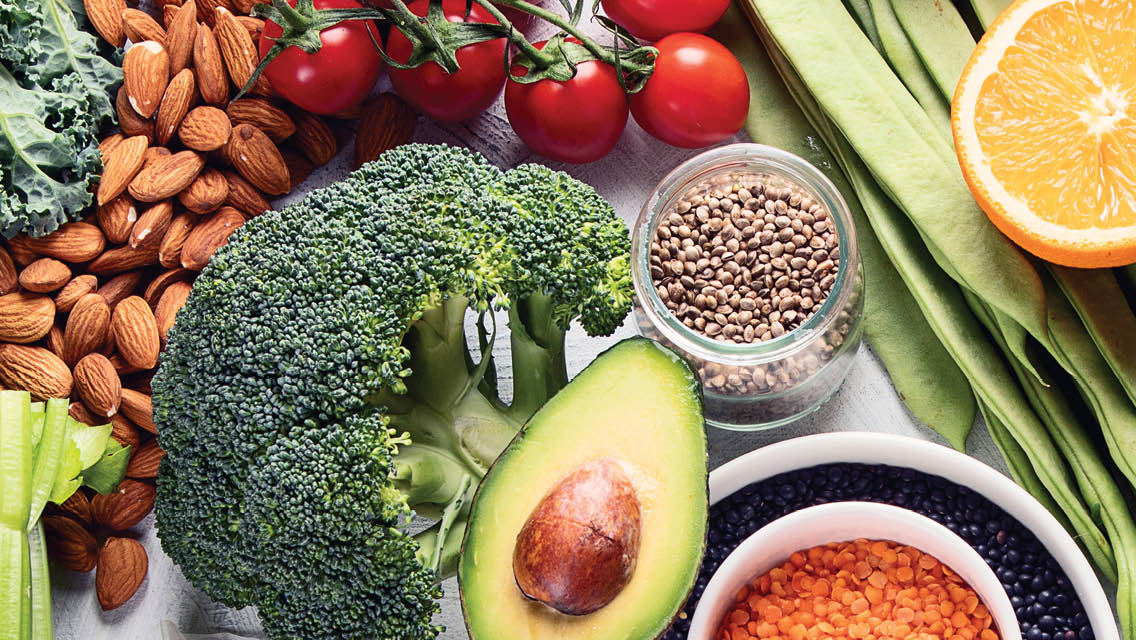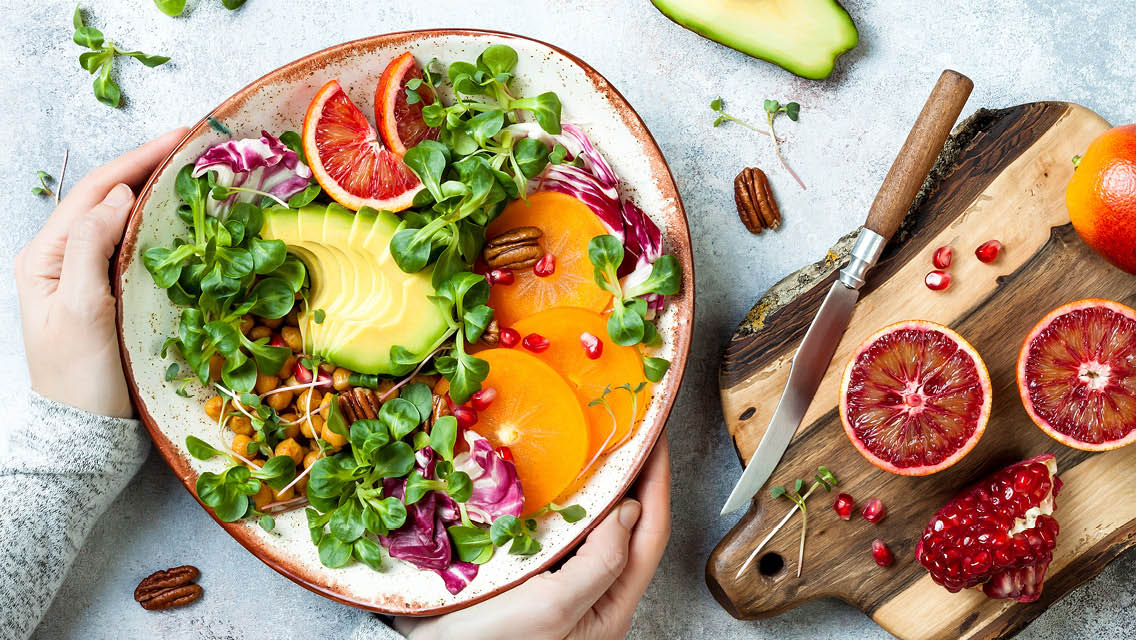When Angela Hofmann was 40 years old, her energy was flagging, her sleep was fitful, and her digestion was out of sorts. “I was struggling,” says the now-60-year-old from Cambridge, Mass.
Her doctor suggested sleeping pills, antacids, even antidepressants. But Hofmann wanted to address her issues through diet first. “It just made sense that if my body was feeling sluggish and ill, the foods I was putting into it weren’t doing their job to nourish and fuel me.”
Hofmann saw a common thread in the nutrition books she read: Eat more vegetables and fruits. She loves a challenge, so she decided to try a vegan raw-foods diet and found plenty of fresh produce at her local grocery store.
But when she began to buy prepared plant-based foods, like cookies and crackers, she was turned off by the cardboard texture and bland flavors. So, she began to make her own.
Today, Hofmann is a chef and owner of Nüssli118°, a raw-foods shop in Cambridge. “Raw food taught me how great it feels to fuel my body with plant-based foods,” she says. “It was the first time in a long time that I felt energized, positive, and vibrant.”
What Is a Raw-Foods Diet?
A raw-foods diet, by definition, moves people away from processed foods and toward whole plant foods — and that shift is almost always a good thing, says functional-medicine provider Will Cole, IFMCP, DNM, DC. “A plant-centric, whole-foods diet will beat out a non-nutrient-dense diet any day.”
Still, like any strict eating protocol, this approach has its limitations, especially for people coping with digestive issues.
Becoming too much of a purist about food can have its own health repercussions. “Some raw-foodists have an almost religious zeal about them,” says Cole. “Anytime our mindset becomes so rigid that pivoting feels like failure, it’s a sign to step back and reassess.”
As with most diets, different bodies will respond to raw foods in different ways. Discover the strategies for finding the raw ratio that’s right for you.
The Benefits of a Raw-Food Diet
A typical raw-foods diet consists of vegetables, fruits, nuts, and seeds that are never heated above 118 degrees F. Some raw-foodists are vegan; others are vegetarian (enjoying unpasteurized dairy and the occasional raw egg) or omnivores (including sashimi and tartare).
Many adherents, like Hofmann, are drawn primarily to the diet’s health benefits. A big part of her motivation to try raw food was a diagnosis of prediabetes. “Faced with the prospect of being on medication the rest of my life, I chose to focus on my diet instead,” she says.
Within a few years of pursuing a largely plant-based, raw diet, she saw her prediabetes disappear. She runs 15 miles a week, practices yoga, and stands all day in her kitchen — capacities she attributes to good nutrition.
In terms of nutrients, a raw-foods diet easily trounces the standard American one. Decades of nutrition research have shown an inverse relationship between daily servings of vegetables and fruits and the risk of type 2 diabetes, heart disease, and many types of cancer.
Studies have shown that plants’ fiber, specifically, lowers the risk of type 2 diabetes, heart disease, and chronic inflammation.
Along with a wealth of plant-based vitamins and minerals, raw foods provide plenty of fiber, which is the basic building material of plants and is abundant in raw foods. Studies have shown that plants’ fiber, specifically, lowers the risk of type 2 diabetes, heart disease, and chronic inflammation.
Yet the average American consumes only half the recommended daily allowance, which is 25 grams for women and 38 grams for men. Many functional-medicine practitioners think that general recommendation is too low and we should aim for 30 to 50 grams.
When we eat a variety of fiber (soluble, insoluble, and prebiotic), we support elimination and nourish the gut microbiome’s flora, which feed on prebiotic fiber, says Cole. A healthy gut microbiome also transforms fiber into the short-chain fatty acids that are vital for a strong immune system and digestive health.
“A raw-foods diet is going to support bacterial diversity and short-chain-fatty-acid production,” Cole says. “And those two things are the name of the game for people who live long, healthy lives.”
The Digestive Challenge
Given the quantity of plant foods it contains, a raw-foods diet can offer a wealth of benefits — but there are caveats.
First, eating raw food triggers a digestive workout, and not everyone’s system is up to the job. A 2018 study in the American Journal of Gastroenterology found that nearly two-thirds of Americans have gastrointestinal distress, including bloating, gas, constipation, and heartburn. This is not a setup for success with raw foods.
“Gastrointestinal symptoms can be exacerbated by increasing dietary fiber,” explains functional nutritionist Jesse Haas, CNS, LN. “Is fiber inherently a good thing? Yes. But will it improve someone’s diet right off the bat? Not necessarily.”
Many healing traditions, including Ayurveda and Traditional Chinese Medicine, believe that one needs a cast-iron gut to handle raw foods — and that it’s best to consume them minimally if gut health is an issue. In his functional-medicine practice, Cole sees many people with irritable bowel syndrome, small intestinal bacterial overgrowth (SIBO), and leaky gut, and he generally has them steer clear of too much raw food. “Eating raw can create a stressful work environment for a gut that is trying to heal.”
For someone struggling with digestive issues, a healthcare provider may recommend a low-fiber diet, such as low FODMAP, to soothe digestive issues.
For someone struggling with digestive issues, a healthcare provider may recommend a low-fiber diet, such as low FODMAP, to soothe digestive issues. (For more on the low-FODMAP diet, see “Can An Elimination or Low-FODMAP Diet Treat IBS?“.) Haas is more likely to have clients reduce their fiber intake temporarily and then gradually increase their tolerance. Once the gut is stronger, they can usually handle more high-fiber foods.
“Ayurveda sees the digestive process as a cauldron over a fire,” explains Haas. “The digestive fire needs to be robust so it can burn up, break down, and digest the energy in foods.”
A raw-foods diet also can create nutritional deficiencies. It may lack vitamins B12 and D; minerals selenium, zinc, and iron; protein; and the omega-3 fatty acids DHA and EPA. Combinations of particular raw foods can deliver some of these, but protein and fats are often stubbornly lacking. And vitamin B12 deficiency can cause nerve damage.
Though plenty of plants, including nuts and seeds, contain protein, the gut will struggle to absorb them if it is inflamed or irritated. Most people on a raw-foods diet don’t consume enough plant protein, says Cole.
Similar challenges are involved in getting sufficient omega-3 fatty acids from plant sources, such as hemp seeds, flaxseeds, and walnuts. Plant-based omega-3 fats must be converted to animal-based omega-3s in the body. But less than 10 percent of the omega-3s survive the conversion process.
On a raw omnivorous diet, you could meet your omega-3 needs with raw fish, but you’d need to eat 3 to 4 ounces of fatty coldwater fish — salmon, tuna, sardines, mackerel, and others — a few times a week.
To be fair, Haas says, consuming enough omega-3 fats is a challenge no matter your diet, but eating only raw foods makes it harder, especially for people who don’t have easy access to fresh seafood.
Eating uncooked animal foods also requires additional safety precautions. Heat kills potentially harmful bacteria that can lead to food poisoning, one of the greatest digestive enemies of all. Safe consumption requires choosing your supplier carefully.
Many experts agree that the healthiest approach to adopting a raw-foods diet is to try it during seasonal transitions, which can be a natural time to detox, or during summer months when access to fresh, seasonal vegetables and fruits peaks.
“If you are eating raw animal products, you want to make sure the animal is being raised, slaughtered, and processed in a clean, healthy environment,” says Haas. “This is critical because otherwise the pathogenic opportunity is just too great.”
Many experts agree that the healthiest approach to adopting a raw-foods diet is to try it during seasonal transitions, which can be a natural time to detox, or during summer months when access to fresh, seasonal vegetables and fruits peaks.
“The optimal diet is something fluid that can change depending on the seasons and circumstances,” advises integrative-medicine physician Akil Palanisamy, MD, author of The Paleovedic Diet.
How to Start Eating Raw Foods
Consuming food raw may seem to be in harmony with our origins as a species, but many anthropologists believe the advent of cooking food helped develop our early ancestors’ brains. Heat makes the nutrients in plant foods more available by softening the cellular matrix, which releases nutrients that the body absorbs during digestion.
Cooking food also decreases the energy the body must use to extract calories. That savings may have allowed people to develop greater executive functioning.
And while an overcooked vegetable can be a deep disappointment, heat doesn’t inevitably destroy all its nutrients. There are plenty of gentle cooking methods that make vegetables easier to digest and leave them nutrient-dense. Cole and other experts believe a small tradeoff is worthwhile. “Sometimes cooking lowers the nutrient content, but the nutrients that remain are going to be more available,” he says.
Haas usually suggests eating a 1:3 raw-to-cooked ratio. She prefers gentle cooking techniques — water sautéing, steaming, blanching, and braising — that allow more nutrients to remain in the food. Because heat will still leach certain nutrients from plant cells, such as vitamin C, Haas saves her cooking water (sometimes called pot liquor) and uses it to make rice, beans, or stock.
Heat will still leach certain nutrients from plant cells, such as vitamin C, Haas saves her cooking water (sometimes called pot liquor) and uses it to make rice, beans, or stock.
Heat can also interfere with the plant enzyme necessary to produce sulforaphane, a potent anticancer compound found in broccoli and other cruciferous vegetables. But British researchers have discovered that powdered mustard seeds, wasabi, and horseradish contain a heat-resistant version of the enzyme. So you can add a small amount to cooked cruciferous veggies and reap the same rewards that their raw form offers. This is good news for those who find raw crucifers tough to digest.
In some cases, cooking a vegetable actually delivers more nutrients. Lycopene, the pigment that gives tomatoes their distinctive deep-red hue, is more easily absorbed from cooked tomatoes than raw.
Fermented foods, meanwhile, offer a middle ground between cooked and raw. The fermenting process relies on microorganisms instead of heat to soften plant-cell walls and release their nutrients. “Fermentation predigests foods, making nutrients more bioavailable,” says fermentation expert Sandor Ellix Katz.
“There is definitely a place in a raw diet for fermented foods,” he adds. “Everybody can benefit from building greater biodiversity in the gut.”
In the end, the best guiding principle remains your body’s feedback.
Haas encourages her clients to embrace the most diverse diet they can, and to avoid a black-and-white attitude toward food. “You can have a beautifully balanced diet, but if you aren’t digesting and absorbing the nutrients, who cares?”
Even Hofmann’s strictly vegan raw diet lasted only about six months. “My kids, ages 4 and 7 at the time, were adventurous eaters, but a raw diet pushed them to their limit, not to mention my husband,” she says. “I needed to find a diet to heal myself and feed my family, so I began to make modifications.”
Today, Hofmann still eats mostly plants, but in her home kitchen, she finds cooking essential, especially during the Northeast’s long, cold winters.
“I try to strike a balance of what is best for my health while still enjoying a wide variety of foods,” she says. “Now I know how great I can feel, so when I start to feel off, I know I can rebalance my diet and get that feeling back.”
7 Tips for Eating Raw
If you want to experiment with a raw-foods approach, experts suggest trying it for a few weeks — ideally during spring or summer — and then evaluating how you feel. These tips will help you stay on friendly terms with your digestion.
- Start with a 1:1 ratio of cooked and raw foods and see how you feel, says functional-medicine provider Will Cole, IFMCP, DNM, DC. He recommends letting your bathroom habits be your guide. If your stools are loose, reduce the amount of raw foods and eat more cooked soups and stews. If constipation crops up, dial up your raw-food intake.
- If you experience bloating and gas, consider adjusting your ratio of vegetables to fruit. “People with underlying gut issues tolerate more fruit better than more vegetables because fruit fiber is gentler,” says Cole.
- Add a splash of apple-cider vinegar or lemon juice to a glass of water and drink with meals, suggests functional nutritionist Jesse Haas, CNS, LN. This helps improve stomach-acid production for stronger digestion.
- If bloating or gas is still a problem, try taking digestive enzymes before meals to help your stomach process the roughage, says Haas.
- Drink plenty of water to help keep things moving through the digestive tract.
- Add warming spices, such as ginger and turmeric, says Akil Palanisamy, MD. This is an Ayurvedic way to help increase digestive “fire.”
- Keep tabs on your energy, mood, cognition, and stamina, says Haas. “Be open to feedback from your body on whether a raw-foods diet is working for you or not.”
This article originally appeared as “The Raw Story” in the April 2022 issue of Experience Life.





This Post Has One Comment
A raw food diet can be incredibly beneficial, though there are points to consider, as you detailed here. It’s important to make the proper changes so that the body can best digest the foods that the body takes in.